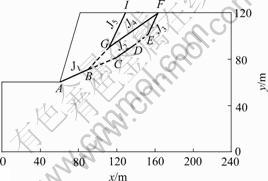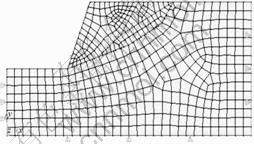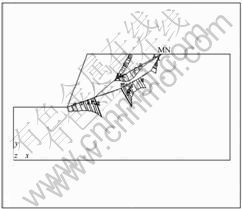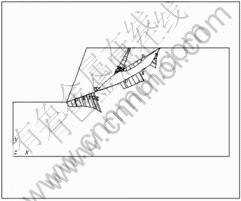J. Cent. South Univ. Technol. (2008) 15(s1): 302-306
DOI: 10.1007/s11771-008-368-1
![]()
Constitutive models in stability analysis of rock slope
YAN Zhi-xin(言志信)1, 2, DUAN Jian(段 建)1, 2, WANG Hou-yu(王后裕)3
(1. Key Laboratory of Mechanics on Disaster and Environment in Western China, Ministry of Education, Lanzhou University, Lanzhou 730000, China;
2. School of Civil Engineering and Mechanics, Lanzhou University, Lanzhou 730000, China;
3. Air Force Engineering Design and Research Bureau, Beijing 100077, China)
Abstract:
Equivalent Mohr-Coulomb yield criterion was established, and the relationship between different constitutive models was studied. The application of equivalent Mohr-Coulomb yield criterion in Ansys was achieved by means of transforming material parameters. The stability research aiming at the most common rock slope without conspicuous slide surface was accomplished, the methods of measurably assessing the stability of rock slope without conspicuous slide surface were explored, and the disadvantages of method of minimum slide-resisted reserve as dangerous slide path were pointed out. The results show that through the calculation and analysis of cases, the conception that measurable assessment of the stability of rock slope without conspicuous slide surface can be achieved under condition that equivalent Mohr-Coulomb yield criterion is validated. Its safety parameter formula is explicit in theory and credible in results. The results obtained are approximate to those obtained by using finite element intensity reducing method.
Key words:
equivalent Mohr-Coulomb yield criterion; constitutive model; rock slope; safety parameter;
1 Introduction
Rock slope has special mechanical properties owing to its unique structure and character of rock. It has almost all the mechanical properties that solid materials have, such as stickiness, elasticity, plasticity, nonhomogeneity, anisotropy, and so on, compared with other materials. This makes it difficult to get accurate answers in most rock projects[1]. The deformation of rock mass not only varies from the level of load under the external load, but also is relevant to the stress of the loading. Besides the reversible elastic deformation, it can also have reversible plastic deformation[2-3]. The researchers not only studied the constitutive models of rock materials but also got the calculating methods of stability safety parameters of rock slope without conspicuous slide surface and proved that it is liable to apply equivalent Mohr-Coulomb yield criterion to the measurable assessment of rock slope stability.
2 Equivalent Mohr-Coulomb yield criterion
2.1 Establishment of equivalent Mohr-Coulomb yield criterion
Since the yield surface of Mohr-Coulomb yield criterion is an informal hexahedron of a rhombohedron in main stress space, the surface’s angles are difficult to be calculated[4]. Equal-surface area transform was made to Mohr-Coulomb yield criterion, that is to transform the angle-unequal, margin-equal hexagon on ![]() plane into a circle whose area remains the same. Thus, a round cone yield surface is built up in main stress space and this makes the programming work easier. The round cone yield surface built in this way is called equivalent Mohr-Coulomb yield criterion. The criterion is a circle on
plane into a circle whose area remains the same. Thus, a round cone yield surface is built up in main stress space and this makes the programming work easier. The round cone yield surface built in this way is called equivalent Mohr-Coulomb yield criterion. The criterion is a circle on ![]() plane, which is also a Drucker-Prager(D-P yield criterion)[5-6].
plane, which is also a Drucker-Prager(D-P yield criterion)[5-6].
According to equivalent assumption, the concrete basic parameters of equivalent Mohr-Coulomb yield criterion are as follows:
Equivalent radius ![]() is
is

![]() (1)
(1)
Then
![]()
![]()
![]() (2)
(2)
Equivalent cone rode angle ![]() is:
is:
![]()
![]() (3)
(3)
where ![]()
Parameters ![]() and k are
and k are
 (4)
(4)
2.2 Realization of equivalent Mohr-Coulomb yield criterion on Ansys
In order to use finite element software Ansys[7-8] with equivalent Mohr-Coulomb yield criterion applied as the yield criterion of rock material at the same time, the transformation relationship needs to be built up among equivalent Mohr-Coulomb yield criterion and exterior angle points and circumscribed circles D-P yield criterion, and the later realizes the application of equivalent Mohr-Coulomb yield criterion on Ansys.
These two criteria (i.e., Equivalent Mohr-Coulomb yield criterion and exterior angle points and circumscribed circles D-P yield criterion) all act as a cone surface in vacuum and a circle on π surface with only difference in parameters ![]() and k. However,
and k. However, ![]() and k are functions relevant to material parameters c and
and k are functions relevant to material parameters c and ![]() . Therefore, taking the relationship among the criteria into account, the actual cohesion c and internal friction angle
. Therefore, taking the relationship among the criteria into account, the actual cohesion c and internal friction angle ![]() of rock mass must transform into the material parameters
of rock mass must transform into the material parameters ![]() and
and ![]() which are necessary to the analysis of Ansys, as Eqn.(6) shows.
which are necessary to the analysis of Ansys, as Eqn.(6) shows.
Assuming that the actual cohesion c and internal friction angle ![]() of rock mass are c and
of rock mass are c and ![]() , the parameters needed in the analysis of Ansys under equivalent Mohr-Coulomb yield criterion are
, the parameters needed in the analysis of Ansys under equivalent Mohr-Coulomb yield criterion are ![]() and
and ![]() . According to the relationship among equivalent Mohr-Coulomb yield criterion and exterior angle points and circumscribed circles D-P yield criterion, there are:
. According to the relationship among equivalent Mohr-Coulomb yield criterion and exterior angle points and circumscribed circles D-P yield criterion, there are:
![]() (5a)
(5a)
![]() (5b)
(5b)
The values of parameters needed in the analysis of Ansys ![]() and
and ![]() are:
are:
 (6)
(6)
2.3 Comparison of parameters among equivalent Mohr-Coulomb yield criterion and exterior angle points and circumscribed circles D-P yield criterion
Assuming ![]() is internal friction angle of rock mass, so its range is 0?≤
is internal friction angle of rock mass, so its range is 0?≤![]() ≤90?,
≤90?, ![]() ∈[0, 1],
∈[0, 1],
![]() <0,
<0,
so
![]() >9
>9
According to Eqn.(6), there is
![]() <
<![]()
 <
<![]()
With the analysis above, the parameters of rock become smaller compared with the original ones after transformation. According to the safety parameters principle of calculating slope safety parameter using finite element method intensity reducing method, the results calculated by equivalent Mohr-Coulomb yield criterion are constantly smaller than those using exterior angle points and circumscribed circles D-P yield criterion.
3 Safety parameters calculation of rock slope without conspicuous slide surface
Ansys is usually used to figure out relative safety parameter F of slide path regardless of its amount. Assuming that ![]() is the maximum anti-slide force that the lower rock brings to resist the relative slide of the upper rock on slide path,
is the maximum anti-slide force that the lower rock brings to resist the relative slide of the upper rock on slide path, ![]() is the actual shearing force upon the lower stable rock which is put on by upper slide rock along slide path, namely descent slide force. Therefore, safety parameter F of rock slope is the ratio of
is the actual shearing force upon the lower stable rock which is put on by upper slide rock along slide path, namely descent slide force. Therefore, safety parameter F of rock slope is the ratio of ![]() to
to ![]() . According to the structure network of rock, the slide path which is random in quantity is an irregular polygonal line pattern made up of polygonal line connected by a rock bridge and structure end to end. Thus, anti-slide force
. According to the structure network of rock, the slide path which is random in quantity is an irregular polygonal line pattern made up of polygonal line connected by a rock bridge and structure end to end. Thus, anti-slide force ![]() is brought out by rock bridge, slide force
is brought out by rock bridge, slide force ![]() is brought out by structure surface. Therefore, the safety parameter F is:
is brought out by structure surface. Therefore, the safety parameter F is:
![]() (7)
(7)
where ![]() and
and ![]() are anti-slide forces and slide forces brought out by all rock bridges along slide path, respectively,
are anti-slide forces and slide forces brought out by all rock bridges along slide path, respectively, ![]() and
and ![]() are anti-slide forces and slide forces brought out by all the structure surfaces along slide path, respectively.
are anti-slide forces and slide forces brought out by all the structure surfaces along slide path, respectively.
3.1 Assurance of anti-slide force and slide force brought out by single rock bridge
Assuming that ![]() is shearing angle,
is shearing angle, ![]() is rock bridge incline angle,
is rock bridge incline angle, ![]() is angle between horizontal direction and direction of principal stress producing tensile chap,
is angle between horizontal direction and direction of principal stress producing tensile chap, ![]() is angle between tensile chap and shearing direction,
is angle between tensile chap and shearing direction, ![]() ,
, ![]() and
and ![]() derive from the data of stress field obtained by making finite element calculation. According to the theory of Lajtai and Einstein, when
derive from the data of stress field obtained by making finite element calculation. According to the theory of Lajtai and Einstein, when ![]() <
<![]() , rock bridge will be damaged in the form of shearing failure; when
, rock bridge will be damaged in the form of shearing failure; when ![]() ≥
≥![]() , rock bridge will be damaged in the form of tensile disruption. The formulas for calculating Ri and Ti under different forms of damage are shown as follows.
, rock bridge will be damaged in the form of tensile disruption. The formulas for calculating Ri and Ti under different forms of damage are shown as follows.
1) Shearing failure (![]() <
<![]() )
)
 (8)
(8)
Where ci is the cohesion force of rock bridge, ![]() is the normal stress put on rock bridge,
is the normal stress put on rock bridge, ![]() is the shear stress intensity of rock bridge,
is the shear stress intensity of rock bridge, ![]() is the shear force put on rock bridge.
is the shear force put on rock bridge.
2) Tensile disruption (![]() ≥
≥![]() )
)
 (9)
(9)
where ![]() is the tensile strength of rock,
is the tensile strength of rock, ![]() is the tensile stress put on rock.
is the tensile stress put on rock.
3.2 Assurance of anti-slide force and slide force brought out by single structure surface
It is simple to calculate Rj and Tj on structure. According to Mohr-Coulomb rule, there are:
 (10)
(10)
where ![]() and
and ![]() are the internal friction angle and cohesion force on structure surface, respectively;
are the internal friction angle and cohesion force on structure surface, respectively; ![]() ,
, ![]() and
and ![]() derive from the data of stress field obtained by making finite element calculation;
derive from the data of stress field obtained by making finite element calculation; ![]() ,
, ![]() and
and ![]() are normal stress, shear stress intensity and shear stress put on structure surface, respectively; L is the length of structure surface.
are normal stress, shear stress intensity and shear stress put on structure surface, respectively; L is the length of structure surface.
4 Case analysis
4.1 Basic information
The height of a rock slope is H=60 m, slope angle β=70?. The physical parameters of rock slope and structure surface are shown in Table 1. Analyzing range is: 2 times of slope height in vertical direction, 4 times of slope height in horizontal direction, as shown in Fig.1.
4.2 Finite element analysis of rock slope
The marginal conditions of finite element model are as follows: land surface and slope surface are free boundary without confinement; the boundary of the model bottom is confined by the displacement in vertical direction; the horizontal boundary of the model is confined by horizontal displacement. Taking rock Plane42 element
Table 1 Material parameters used in calculation

as its unit, and contact172 and targe169 to investigate structure surface, the model was divided into 590 units and 553 nodes, as shown in Fig.2. After finite element calculating in Ansys, normal stress on structure surface ![]() and shear stress
and shear stress ![]() are shown in Figs.3-4.
are shown in Figs.3-4.

Fig.1 Slope section

Fig.2 Finite element calculation model

Fig.3 Normal stress on structure surface σn

Fig.4 Shear stress on structure surface τs
4.3 Assurance of rock slope slide path
According to the searching principle of rock structure surface network and rock slope slide path, this rock slope case has 3 paths: A→B→C→D→E→F, A→B→G→F and A→B→G→I.
4.4 Assurance and validation of rock slope dangerous slide path
By analyzing the results of slope stress field in finite element method and using path tools in Ansys, with the judgment of damage upon rock bridge, through numerical integration of stress along the path of structure surface and rock bridge, anti-slide force, slide force and slide-resisted reserve are shown in Table 2.
With the data in Table 2, the results of different slide paths are shown in Table 3.
It can be seen form Table 3 that the safety parameter of path A→B→C→D→E→F(2.828) is the smallest one in these three paths, it is the dangerous slide path of this rock slope. The total slide-resisted reserve of path A→B→G→I(30 892 kN) is the smallest in these 3 paths. However, its relative safety parameter is 3.059. So it can be concluded that it is not the safest path. After analyzing the stability of rock slope with finite element intensity reducing method further, the safety parameter of this rock slope is 2.796, relatively close to the one of path A→B→C→D→E→F. So the algorithm presented by SHAN and CUI[9], i.e. the path of which total slide-resisted reserve is the smallest is the dangerous slide path. It is inaccurate and needs to be amended.
Table 2 Results of rock bridge and structure surface

Table 3 Results contrast analysis of different paths

5 Conclusions
1) Equivalent Mohr-Coulomb yield criterion can be applied in the analysis of rock material elasticity and plasticity model and can also be applied using the giant finite element software Ansys. Meanwhile, the magnitude relationship of transformed material parameters and original ones is validated, that is, transformed parameters are constantly smaller than those of the original ones. Therefore, the results calculated by using equivalent Mohr-Coulomb yield criterion is constantly smaller than those calculated by using exterior angle points and circumscribed circles D-P yield criterion.
2) The results using finite element analysis can demonstrate the stress distribution of rock slope without conspicuous slide path along different paths reasonably and correctly and realize the accurate calculation of rock slope safety parameter.
3) Taking equivalent Mohr-Coulomb yield criterion into account, the safety parameter obtained by using finite element software Ansys is very close to that obtained by using finite element intensity reducing method.
4) The results obtained by the algorithm that selecting the path with the smallest total anti-slide force is inaccurate, it needs to be amended.
5) Although the safety parameter of rock slope without conspicuous slide path studied is larger than 1, the rock slope is constantly changeable, the parameter of rock slope becomes smaller and smaller, with the changeable speed becoming faster and faster in the last phase, finally, the safety parameter loses stability.
References
[1] LADE P V. Elasto-plastic stress-strain theory for cohesionless soil with curved yield surface[J]. Intern J Solids and Struct, 1977, 11(6): 1019-1035.
[2] ZHENG Ying-ren, SHEN Zhu-jiang, GONG Xiao-nan. The principle of geotechnical plastic mechanics[M]. Beijing: China Architecture and Building Press, 2003. (in Chinese)
[3] LADE P V. Modeoling yield surface for granular in three dimensions[J]. Computer Methods and Advances in Geomechanics, 1997, 25(4): 79-89.
[4] SUN D A, MATSUOKA H. An elastoplastic model for c+φ materials under complex loading[C]//9th Int Conf on Computer Methods and Advances in Geomechanics. Balkema, 1997.
[5] SHI Wei-min, ZHENG Ying-ren. The equivalent transform of Mohr-Coulomb yield criterion and its application in rock slope analysis[J]. Geotechnical Engineering Technique, 2003, 17(3): 155-159. (in Chinese)
[6] XU Gan-cheng, ZHENG Ying-ren. The study of yield criterion application in rock projects[J]. Chinese Journal of Geotechnical Engineering, 1990, 12(2): 93-99. (in Chinese)
[7] LIU Tao, YANG Feng-peng, LI Gui-ming. Mastering ANSYS[M]. Beijing: Tsinghua University Press, 2001. (in Chinese)
[8] Bojia Science and Technology. Achieve mastery through a comprehensive study of finite element analysis soft-ANSYS[M]. Beijing: ChinaWater PowerPress, 2002. (in Chinese)
[9] SHAN Yan-jing, CUI Jun-zhi. Expectant slide route method of rock mass stability analysis in view of Statistical Model of structure surface and stress field[J]. Chinese Journal of Rock Mechanics and Engineering, 2002, 21(2): 151-157. (in Chinese)
(Edited by CHEN Can-hua)
Foundation item: Project(10672191) supported by National Natural Science Foundation of China; Project(06JJ50093) supported by Hunan Provincial Natural Science Foundation of China
Received date: 2008-06-25; Accepted date: 2008-08-05
Corresponding author: YAN Zhi-xin; Tel: +86-931-8632418; E-mail: yzx10@163.com
- Constitutive models in stability analysis of rock slope


